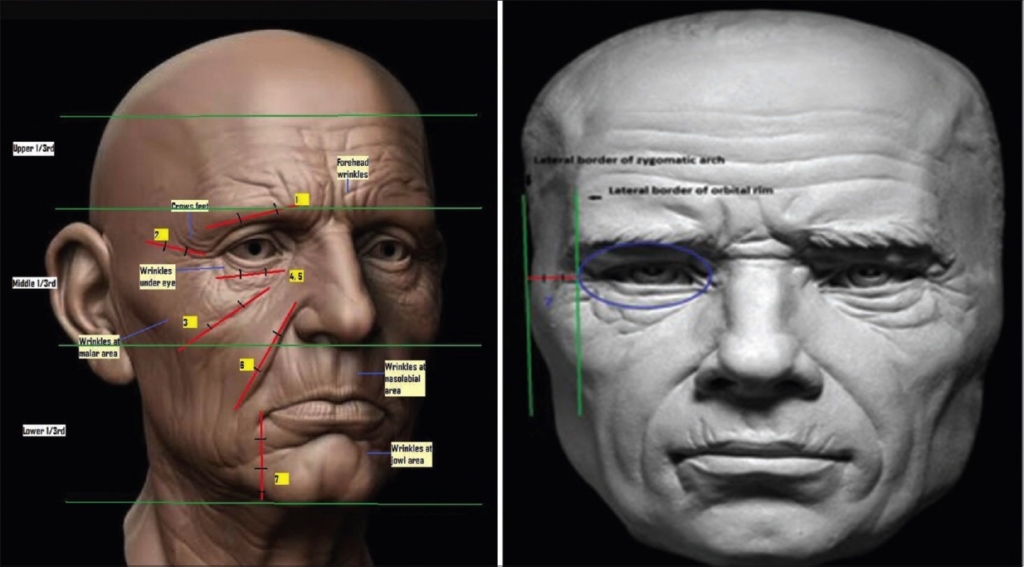FACIAL AGEING
AND VOLUME LOSS
Assessing and determining the changes and the effects in the skin particularly the face remains a challenge

Facial aging is a complex process with structural and physiological changes that happens to the skin and associated structures.
Ageing of the human face occurs as a combined result of both superficial skin texture wrinkling and three dimensional changes that occurs to the underlying structures. In general, the process of ageing occurs with changes in skin, subcutaneous tissue and fat, muscles and the underlying fascia and also the underlying structures that majorly comprises of the bone and teeth.
The major factors that lead to changes in the skin include gravity, skeletal remodelling, subcutaneous fat redistribution and loss, hormonal imbalance, chronic solar exposure, and smoking. In addition to this other environmental factors that result in a aged facial appearance include mental stress, dietary habits, work habits and diseases.
Assessing and determining the changes and the effects in the skin particularly the face remains a challenge to the dermatologists and Maxillofacial surgeons. So, distribution of the face into compartments while assessing, can resolve and bring out the best outcomes.
In terms of facial rejuvenation the area should be considered in 3 dimensional rather than a 2 dimensional perspective and restoration of a youthful 3-dimensional facial topography is regarded as the primary goal in facial rejuvenation.
Facial volume and ageing
There are numerous components that contribute to the changes in the skin texture leading to volume loss of the skin in the face and they are;
a. Skeletal components
Anatomic changes happen in the craniofacial skeleton and it occur as a result of change in the relative dynamics that happens between the bone expansion and bone loss. Obvious changes in the maxilla and mandible can lead to appreciable reduction in the facial width and height.
Resorption of the facial bones particularly the maxilla with decrease in size as age advances, can lead to displacement of fat towards adjacent soft tissue structures leading to an aesthetic concern. Maxillary bone changes can lead to inferior displacement of the orbital fat, sagging of the skin, loss of support of the upper lip, accentuation of the nasolabial fold and perioral wrinkling.
In the mandible, loss of teeth could eventually result in changes in the alveolar bone and over the time leading to structural changes in the chin as well.
b. Subcutaneous fat
Major changes in the facial skin in the ageing process is the subcutaneous fat as the youthful face is characterized by equal and balanced distribution of the superficial and deep fat in a 3 dimensional pattern. It is best expressed by a series of arcs and convexities like the OGGEE curve, primary arc of the jaw line, arc of forehead etc. As age progresses there will be loss of soft tissue fullness in certain areas and there will be hypertrophy and excess in other areas. As a result of the redistribution, the subcutaneous fat which is masked by the extracellular fluid will dissipate and form bags leading to a senile face with an unbalanced appearance.
Facial volume loss
To assess the morphological manifestations, facial volume is divided into thirds and they are;
a. Upper third
Upper third of the face mainly constitute the area over the forehead, brows, orbit and the temple region. The subcutaneous fullness of the skin over the forehead region disguises the muscles of facial expression. As age progresses there will be loss of subcutaneous fullness to the brows, temple and orbital region which will make the underlying bony structure more prominent. Following the loss/dissipation of the subcutaneous fat the underlying bony structures (upper eyelid, temporal) becomes more evident and the muscles over the area (corrugators, procerus etc.) will give off a torturous appearance. Temporal support to the eyebrow region will slowly diminish and loss of support to muscles (orbicularis oculi) will lead to ptosis. The presence of subcutaneous fat give fullness to the face and as age progress the intrinsic tone of the muscles mainly the glabellar and the procerus will fade away resulting in wrinkles and folds. Altogether, skeletonised supraorbital rim, temporal hollowing, forehead furrows, excess upper lid, sagging of the lower eyelid can all lead to the upper facial ageing.
b.Middle third
It mainly comprises of midface and the nose and is the most notified area of the face. As age progresses, loss of subcutaneous fullness over the malar region will be evident. Buccal hollowing along with loss of support and intrinsic tone to the orbicularis oculi muscles on the skin will lead to ‘Crows Feet’.
Loss of fullness over the infraorbital region leads to sagging of the skin resulting in concealed infraorbital fat pads and ‘Tear Trough’ depression, giving a tired face appearance. Dark discoloration of the infraorbital skin may be seen, attributable to dermal melanin deposition.
Most of the changes in the middle third of the face concentrates in and around the nose, glabellar and the medial eyelid region, with an increased nasal length appearance.
All together the Malar crescent, Increased nasal length appearance, Bunny lines, tired eye face, Crow’s feet, Infraorbital fat bags results in morphological manifestations of the face with ageing.
c. Lower third
It mainly comprises of the chin, jaw line and the neck region. As age progresses, with the malar crescent and infra orbital fat bags there will be depletion of the fullness of the skin and progressive migration of the buccal fat inferiorly towards the mandible with relatively excess skin in the lower face leading to loss of jawline.
Loss of ligament support to the Massetric muscle will allow the facial fat to decent downwards leading to formation of ‘Facial Jowls’.
Ptosis of the unsupported skin, chin pad, and facial portion of the platysma muscle, coupled with the downward pull of the platysma muscle, leads to the development of the characteristic jowled “turkey neck” deformity.
